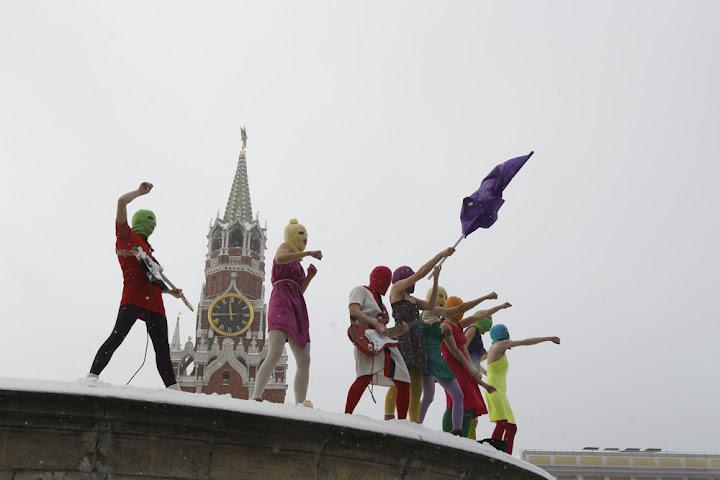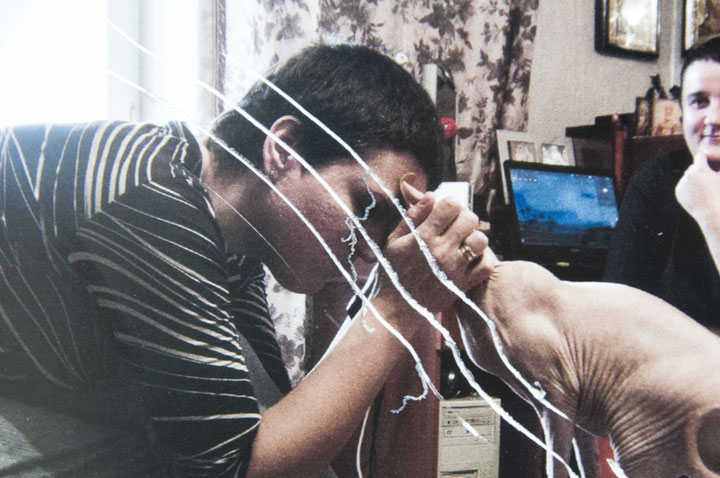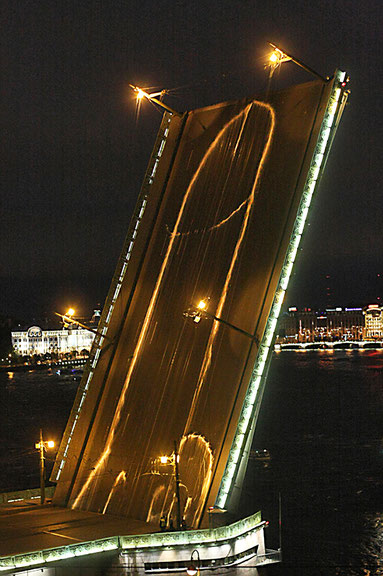Issue 3/2012 - Art of Angry
Upward revaluation in times of crisis
In Russia and Ukraine, administrative sanctions and repressive state measures directed at provocative forms of art are on the rise – greatly enhancing the status of political art.
In Moscow, lawyers classify the filming of a short video in the Cathedral of Christ the Saviour as »hooliganism« - under the Russian penal code, this offence is punishable with up to seven years' imprisonment. In Kyiv, the rector of the renowned Mohyla Academy referred to an exhibition as »shit« and banned the organiser, the Visual Culture Research Centre (CVK), forthwith from the campus of his university.
It is difficult to compare the relative importance of these two recent cases in Russia and Ukraine. But one parallel immediately comes to mind: both countries are currently experiencing a heated discussion on how far art is allowed to go in a way that has not been seen there for a long while. And for the first time in a long while, people in authority are speaking out to define the limits of art and wanting to use their position or the power of the state to enforce them.
In Kyiv, the censorship of »The Ukrainian Body« set a precedent. Statements from a person in authority à la »That is not an exhibition, that is shit« - which is how rector Serhiy Kvit expressed himself, according to the director of CVK, Vassil Cherepanin - have not been made in the recent art history of the country, nor has an exhibition ever been closed in such a way for such or similar reasons.
In the exhibition that ended up being closed by the rector, the CVK, founded in 2008 as part of the Mohyla Academy, had examined the body as a political playing field – and sometimes even minefield. Among other things, the Kyiv artist Anatoliy Byelov had shown drawings from 2009 referring to the ban on possessing »normal« pornography that a state »morals commission« had initiated at the time. Byelov's graphics each show a naked man with an erect penis photographing himself in front of a mirror, accompanied by the phrase »My porn, my right!«. There had been other disturbing works in the exhibition, such as a two-canal video installation by Mykola Ridnyi: Ridnyi, a media artist from Kharkiv, showed abstruse animal biscuits disappearing into a woman's vagina synchronously with monotonous scenes of behaviour during votes in the Ukrainian parliament. This work from 2005 referred to the growing disappointment with the Orange Revolution.
»If the rector hadn't closed the exhibition, the Academy would have been accused by its many radical critics of promoting >pornographic pseudo-art<,« Andreas Umland, a German political scientist who teaches at the Mohyla Academy, said. Admittedly, in the case of »The Ukrainian Body,« one could speak neither of »pornography« nor of »pseudo-art« - many of the works in this group exhibition had already been shown, and the list of participants read like a small Who's Who of the recent Ukrainian art scene. Kvit's description of it as »shit«, however, points up the new significance of politically engaged art. Contemporary art in Kyiv as a whole has gained a new prominence, partly because of professional institutions such as the private PinchukArtCentre or the state-run art biennale Arsenale 2012. In addition, political art and the political mainstream have moved closer to one another, as art increasingly touches on problems that have the potential of awakening a huge public resonance. The best (and extremely worrying) example of this is the documentary photographs that Yevgeniya Belorusec presented first in the group exhibition that was censored, and then in May in a solo exhibition in the new location of the CVK. Against the background of a homophobic campaign (waged in Ukraine by right-wing extremists whose views are largely tolerated by the state, and in Russia by the state bodies themselves), even empathetic photos showing LGBT family scenes become a form of activism. Belorusec's photos were more or less destroyed by right-wing extremists at the CVK in May. And one of the main figures in her portraits, a Kyiv gay rights activist, has now requested political asylum in the Netherlands.
At any rate, one can speak of a new quality to the old, modernist row about the borders of art. But the discussion is much more virulent in Moscow – the »punk prayer« in the Cathedral of Christ the Saviour unleashed pro-and-contra demonstrations in front of courthouses and churches, and there was and is an intensive campaign by Kremlin-friendly media calling for the criminalisation of political actionism/activism in the field of art. In spring 2012, even the Russian head of state made a statement on it – this had not happened in the country for decades in such a manner and from the highest or even very highest level. Up to then, provocations and attacks had been dealt with at a much lower political plane in post-Soviet Russia: in 2007, the then minister of culture, Aleksandr Sokolov, had described an exhibition with the titel »Sots-Art – Political Art from Russia« in the state-run Tretyakov Gallery as a »disgrace to Russia«. The bone of contention was a photograph by the artists group Blue Noses showing two policemen kissing fervently in a birch wood. There were no consequences for those involved, however.
Official interventions
In 1962, things were very different. Back then, the Soviet head of state Nikita Khrushchev heralded the end of a comparatively liberal policy on culture with a visit to an exhibition. After the so-called Thaw in the previous years, during which even abstract art could be exhibited to a limited extent in the Soviet Union, while visiting the show »Thirty Years of Moscow Art' Association« Khrushchev described artists as »poofs«, spoke of »shit« and called many works »anti-Soviet«. This was practically tantamount to an occupational ban.
The political gesture of the artists, who no longer wanted to tolerate the regime, had consisted merely in violating the state-imposed canon of socialist realism and thus more or less championing the autonomy of art. After Khrushchev's crushing criticism, the now »non-official art« moved into private venues for decades. To be able to exhibit on an official basis and receive commissions, artists had to be members of a state-run artists institution; attempts to put on public artistic presentations that had not received the blessing of the respective state institutions were blocked by the police and the KGB. In 1974, art history was even made by construction machines – bulldozers ended an open-air exhibition in the Moscow district of Belyaevo.
Since the late 1980s, however, interventions by the authorities were passé and state attempts to enforce an artistic canon with aggression were for a long time unimaginable in the new Russia. But a discourse on the topic still exists. At an event during the presidential elections in 2012, the well-known painter Ilya Glazunov, who is recognised for semi-official portraits and a kind of Russian Orthodox Pop Art, called on Vladimir Putin to introduce measures to revive Realism and limit other forms of contemporary art. In his remarks, Glasunov particularly made fun of an exhibition where the main item was a pissoir. In his response, Putin seemed much more liberal than the artist and appealed for nothing to be banned. »But Realism must certainly be promoted. Not socialist realism, just Realism,« Putin, then a presidential candidate, said. A few weeks later, the Russian government illustrated its commitment to »Realism«: Glasunov's private academy received one of the greatest increases in subsidies of all the art schools. On the website of his institution, Glasunov leaves few doubts about its fundamental artistic orientation: »The academy sees the rebirth of those great traditions of national European art that defend the great Realism as its highest goals.« While pissoirs and »great Realism« coexist peacefully, the situation with regard to actionist and activist forms is rather different. And here, too, a clear development can be discerned: at first a long phase in which practically everything was possible and the state kept out of the way, increasing state interventions at relatively low levels, and finally the escalation in 2012.
A short review: For one action in 1991 – the artists group E.T.I., including Anatoliy Osmolovskiy, had arranged 13 bodies on Red Square in the form of a Russian swear word – the Soviet authorities still instituted criminal proceedings. But these were soon broken off. After this, almost anything was possible in Moscow's public space up into the late 1990s – even more radical actions by artists such as Aleksandr Brener, Oleg Kulik and Anatoliy Osmolovskiy were never seriously prosecuted. Only in the late 1990s did this situation begin to change: without any visible coordination at a higher political level, subordinate investigative authorities instituted criminal proceedings against the more radical actions and art works – mostly in connection with critical commentaries on the increasingly politically important Russian Orthodox Church, often with reference to Paragraph 282 of the Russian penal code, »Stirring up religious hatred«. Action artists such as Avdey Ter-Oganyan and Oleg Mavromatti fled abroad to escape such prosecution, and curators such as Andrei Yerofeyev and Yuri Samodurov were each fined. Radical artistic actions in public then took a back seat for several years, partly because of the increasing regulation of the public space by authorities. It was not until 2008 that the artists group Voina – at the time virtually the only one to stick its neck out in this way – initiated a change in trend: its crazy actions in public, always directed against symbols of state power, caused a furore internationally as well. These included orgies in museums, attacks on police stations, turned-over police cars and a huge phallic symbol opposite the secret service in St. Petersburg. Even though the group obviously just scraped by the law and was sometimes actually prosecuted by the authorities, there was no systematic state sanctioning of Voina. On the contrary: »Dick Captured by the FSB« - the huge phallic symbol – even received the prestigious innovation prize presented by the state centre for contemporary art.
In 2012, this situation changed: actionist and activist forms or art are now so close to the mainstream of the relatively large protest movement against Putin's regime that they are seen as a threat by the authorities and are combated with a severity that has up to now not been seen in the new Russia. The group Pussy Riot recently received the full brunt of this. This actionistically oriented women's collective, which calls itself a »feminist punk group« and intersects with the artists group Voina both in some its members and its ideology, came on the scene for the first time in autumn 2011 filming videos without permission: colourfully clothed young women who wrapped themselves up in just as colourful woollen caps had made a spectacular appearance on the roofs of trolleybuses. A short time later, the filmed material turned up on the internet – in the music video for a punk song with the title »Release the Cobblestones«, which was stylistically reminiscent of the German band Atari Teenage Riot.
The lyrics and commentaries published at the same time on pussy-riot.livejournal.com left few doubts about the politically activist orientation of the collective. The song, in which, among other things, includes the phrase »Turn Red Square into Tahrir!«, was dedicated to the upcoming Russian parliamentary elections on 4 December 2011, as was announced at the start of November 2011. The title referred, Pussy Riot said, to the cobblestones that are placed under the incumbent Moscow mayor, which were to be used »appropriately«. At the same time, the group emphasised its feminist orientation; there was also talk of a début album called »Kill the Sexist!«, the main issue of contention being a legislative amendment directed against abortion.
Massive vote rigging then led in December, rather surprisingly, to a broad-based protest movement rooted in civil society. Pussy Riot provided both images and the soundtrack for it. For example, the group filmed scenes for more music videos in front of a Moscow jail in which leading figures in the protest movement were serving time for by-law infractions, on Red Square and finally in the Cathedral of Christ the Saviour. After Stalin had this building torn down in the 1930s, the church was rebuilt in the mid-1990s as closely as possible to the original. Since then, it has been seen as a symbol of the political power of the Russian Orthodox Church, which is becoming increasingly confident in its actions and makes no bones about its support for Vladimir Putin and his regime. It was in this very building that Pussy Riot made a video showing a »punk prayer« with the succinct title »Mother of God, get rid of Putin!«: »Our performance was peaceful in nature, we didn't destroy anything in the church, used no swear words, and everything was conceived as a completely unaggressive musical performance with elements of a prayer,« the group said. Some members briefly danced in front of an altar before they were driven away by security personnel.
The reaction of the regime, which was involved in campaigning for the elections, was not long in coming – after an intermezzo as prime minister, Vladimir Putin was to be voted in as president for the third time on 4 March 2012. Putin expressed his explicit displeasure at the incident in the church, and his press spokesman Dmitri Peskov added: »This action cannot be described as anything but repugnant.« And the outgoing president, Dmitri Medvedev, stated that Pussy Riot had got what they wanted – popularity. A short while later, Patriarch Kirill, who was criticised by Pussy Riot in the lyrics of their song, gave an inflammatory speech that left nothing to the imagination: »We have no future if we start debasing the great holy cities. And if this debasement is seen as a kind of heroic act, as a permissible means of political protest, as an appropriate action or as a harmless joke.«
The reaction of the law enforcement agencies was even less ambiguous. They immediately instituted proceedings on suspicion of hooliganism and arrested the three alleged participants in the video filming. Unsurprisingly, the obsequious Moscow courts sentenced the three young women to be held in pre-trial detention for several months. Amnesty International has now recognised them as political prisoners.
Apart from a seemingly completely exaggerated reaction on the part of the state, the case of Pussy Riot also highlights a larger context: that of the massive upwards revaluation of artistic actionism and activism in the semi-authoritarian Russia. Nearly every gathering of people that could potentially be critical of the regime or of society runs the risk of being batoned down by the police or of leading to sometimes crippling fines under harsher laws. This does not apply solely to political demonstrations, but also to current artistic presentations such as open-air painting by Moscow artists who – with reference to the colour of the protest movement – painted white portratis of the Kremlin on a white background. Or a roaming gallery organised by the curator Yuri Samodurov. And even public lectures at places deemed oppositional in nature – this recently affected the philosopher Boris Groys, for example – always took place against the background of imminent police violence in the spring of 2012. A background that however also ensures pathos and relevance.
Translated by Tim Jones


